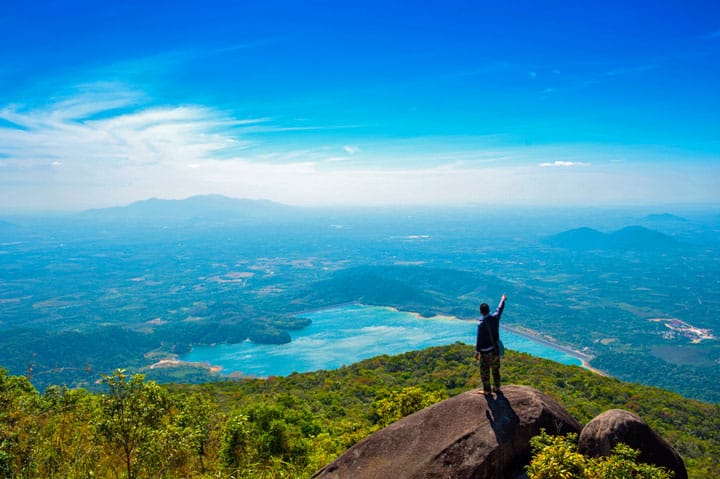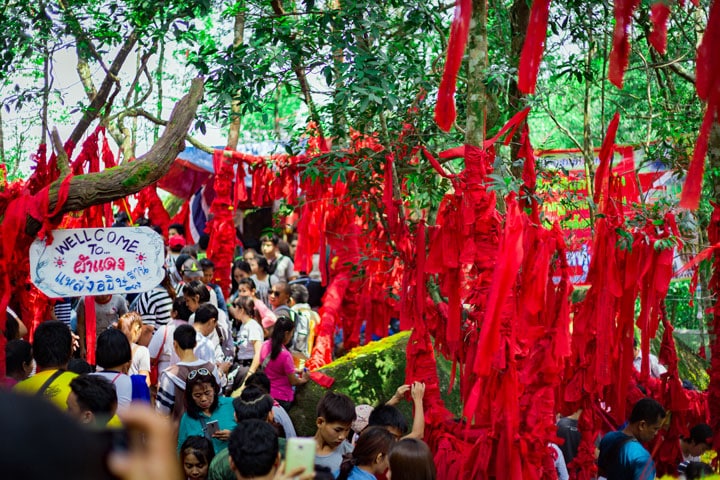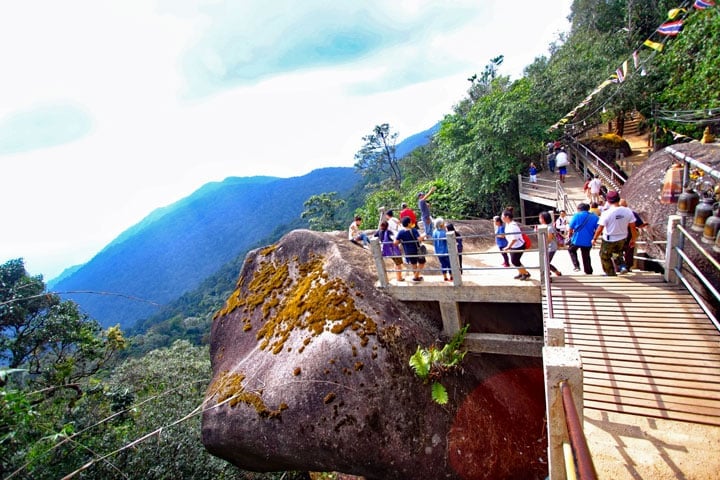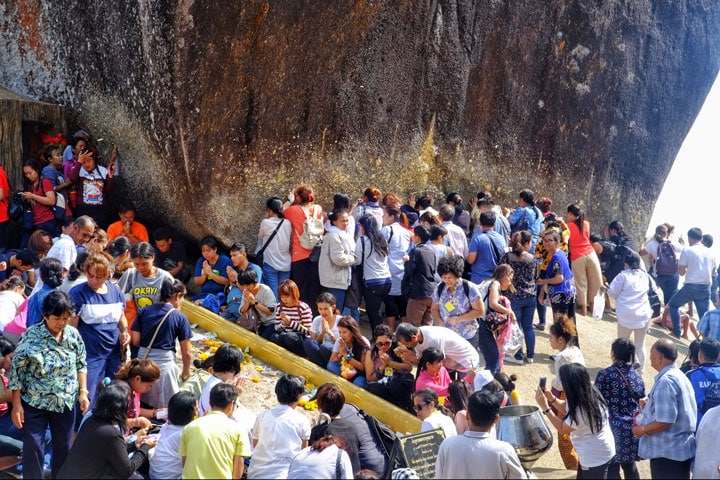Khao Kitchakut, a hellish journey to Nirvana?

Khao Kitchakut National Park, Chanthaburi
You won't hear me complaining! I suggested it myself. I had seen some pictures from a close acquaintance of her visit to Khao Kitchakut and I wanted to get out and see something different from what I see every day in Pattaya.
“Let's go to Khao Kitchakut for a day,” I said to my wife. Khao Kitchakut is a national park with an area of almost 50 km², not too big, but the special thing is that the mountain Khao Phrabat is located in that park, where a footprint of the Lord Buddha can be seen.
The park is only open to the public for the first three months of the year. It has become a veritable place of pilgrimage for Thais, who come from far and wide to Chantaburi to see that footprint and to express their Buddhist feelings in various ways through countless small or large sacrifices along the way.
My wife thought it was a great idea from me, arranged a minibus and we went there last Sunday with a group of 10 people towards Chanthaburi, 9 Thais and me as the only Farang. We would leave early and expected to be back in Pattaya around three o'clock in the afternoon because some of them had other commitments that day. What is early? I played a tournament in the pool hall on Saturday evening, came home at about two in the morning and thought I could sleep for a few more hours before leaving for Chanthaburi. Wrong thought! I was able to take a shower and put on other clothes plus hiking boots and we left at about three o'clock.
To Chanthaburi
The ride to Chantaburi went well, our excellent driver (my brother-in-law) drove quietly on highways 36 and 3 and after making a stop on the way for food, drinks and sanitary care, we arrived in the village at about six o'clock the foot of Mount Khao Kitchakut. From that point on, as a non-Thai and non-Buddhist, I was tested for a long time. We were not the only ones who came up with the bright idea to come to the mountain that Sunday. I didn't count but in the parking lots I saw hundreds of cars, dozens of buses and minibuses parked and the number of visitors must have run into the thousands.

Eddy Tor Channarong / Shutterstock.com
To wait
From that village you have to go up the mountain and the only means of transport is a pick-up, which takes you up for 30 Baht per person. Tickets were bought, but we had to wait our turn because there were some(!) waiting before us. We had number 1373 and at that time people with number around 350 were brought up. Each number could exist for 2 to 10 passengers and for us the long wait for our turn began. At that moment I had already wanted to end the adventure myself, but my traveling companions took it resignedly and I could not help but resign myself to my fate of that day with a smile.
Fair
The village is one big fairground. My apologies for this name, I couldn't see it any other way. In addition to the many eateries that were obviously busy, during my tour of the village I counted more than 20 Buddhas, each with a few monks, who – sometimes with a microphone – competed against each other to make an offering to Buddha, especially with them. Buddhas in the female form on a pedestal, reclining Buddhas, the pot-bellied Buddhas, elephants, tortoises and what could not be worshipped, of course accompanied by a monetary sacrifice. Our group also took the time to buy all kinds of items that would be used for the offerings on the way up.

Na khanti / Shutterstock.com
First leg
At half past ten it was our turn. One of the more than 100 available pick-ups took us upstairs. Initially still on a concrete road, but soon we dived into the forest, where the road was unpaved and led upwards with really sharp bends. After being rattled around for half an hour we were there. At least that's what I thought, but from there the second leg started, which was again provided by pick-ups. The wait now only lasted two hours, offerings could also be made there and there was food and drink for sale. That journey took about twenty minutes to the foot of Khao Phrabat.
Second and third stage
But we are not there yet because now we still have to walk the last kilometers to the top. That meant climbing endless stairs, sometimes a small oasis with shops, then shuffling past 100 copper bells, each of which is touched three times with a coin by the Thais. But then after about 40 minutes we are at the top that you can consider as Nirvana. Waiting again in a huge crowd to make the supreme sacrifice to the footprint of Buddha near the big rock, which is known as the hallmark of Khao Kutchakut. I stopped there for a while. I didn't have to make a sacrifice, I found a quiet spot and watched the passing crowd for an hour, also interesting.

Na khanti / Shutterstock.com
Descent
The descent went more smoothly than the climb, but it had rained a bit, so on the wooden planks and the clay soil, we had to be careful not to slip away. Then it was back to waiting for a pick-up truck down. Well, you get used to it, so to speak, so my mood didn't change during that three-hour wait. We were back in Pattaya at XNUMX:XNUMX PM and there was no one in the group who could still say 'Dad'.
Transportation
There is still something to report about the transport up and down. As mentioned earlier, the transport is provided with pick-up trucks. Each has a number and when leaving, a man on a platform mentions the number of the car and the group that can sit on it. Pretty well organized I must say. I estimate the number of pick-ups at two to three hundred, which are therefore used for the first and second leg. The pick-ups, all apparently quite new, not only come from the area but are hired from all corners of the world. The drivers are paid per journey and also stay overnight in order to make as many journeys as possible in the short period of three months. The winding and uneven road upwards with gradients of more than 20% must mean a real attack for, for example, the clutch disc, brake pads, etc. of the pick-up.

Na khanti / Shutterstock.com
Safety
The route is winding, uneven and steep and that requires good driving skills from the drivers. The cars going up always take the outside bend, down the inside the bend. This means that there is a regular switch from left-hand traffic to right-hand traffic and that is well indicated with signposts.
When we had to go down a problem occurred, which extended the waiting time considerably. It had rained a bit, which made slipping a possibility and the “traffic control” had now set up one-way traffic. A column of about 20 pick-ups went up and on arrival at the second level, the column, now packed with descending passengers, could go down. So no oncoming traffic along the way.
Logistics
While waiting for the descent, I regularly saw pick-ups, who had to provide supplies for the eateries and the temple at the top. On the last stretch of a kilometer or two this was taken care of by porters. On the way up we had already been passed by a dozen porters, each with a butane bottle on their shoulders, who then carried a bag of rubbish or something with them. Those porters get 100 Baht per trip uphill / downhill and to collect a reasonable income, they will have to make that trip quite a few times. All respect to these men!
Finally
The entrance to this spectacle was free, also for me as a foreigner. The only thing that had to be paid was the transport up and down, which amounted to 100 Baht per person.
It was interesting to experience but we shouldn't have gone on a Sunday, way too busy. We now know how to organize that better next time. But for me there will be no next time, I've been through it and given me you won't get that way again.
– Reposted message –


It all sounds ordinary. Only the mountain by car 4×4 is only open 2 months a year at the beginning of Feb. until the end of March due to rain. The whole way can also be done on foot.
The 4×4 pick-ups are only allowed to take a certain number of people. They are not only paid per ride but also per head, so they usually take double.
The fatalities are NOWHERE mentioned, but they are there. The last part of walking has already improved until 6 years ago there were no stairs and the steps were either tree roots or carved into the mountain side.
This mountain is just as sacred and every Thai must have visited it at least once in their life, just like Mecca
We, my Thai wife and I have already gone up the mountain a few times. The last time was 2 years ago. I am now 84 years old, so 82 years old at the time. From the village you go up in 1x with a pickup, where you then have to cover the last km yourself over largely a natural staircase. Ie tree roots, steps of clay soil and the occasional piece of irregular concrete steps. I have never had any problems with (begging monks), never even seen them. You can say something, but I think this gentleman has been a little over tired. It's just a very nice outing that I would definitely recommend to anyone who is still a bit agile
Never again for me. Did it once then I was in bed for 3 days from climbing…no baja never again!
I am very sorry for you. But you have not yet reached nirvana. You will have to make the trek 3 times in your life. Considerable effort, but you get the nirvana in return. At the moment (7.2.2016) the mountain is still closed due to impassable roads due to the rain. The mountain is scheduled to open on February 16. We are ready.
I've been there too. Got halfway up the mountain.
After the 1st stage I had to transfer. But I took a few pictures first.
Then I stepped between the cars that had just come down to the ticket box to get a ticket for the 2nd stage.
I was helped by Thais who showed me where I could buy my ticket.
And then I was shown in which pick-up I had to take a seat with my just purchased ticket. And then we started driving. Down.
I immediately understood why. I was thought to be coming out of one of the pick-ups on the way down when I took a few photos. Own fault actually.